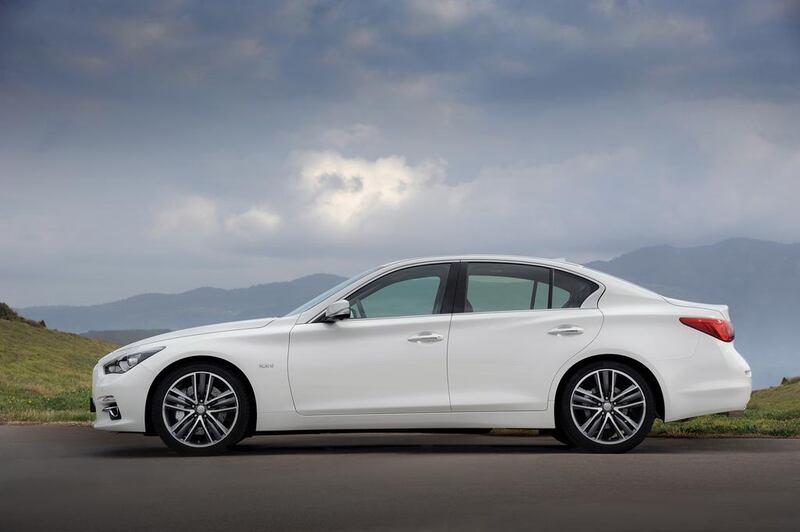I’ve said it before but it bears repeating: I am a self-confessed dinosaur. It’s not that I don’t like or cannot grasp new technology, but I’m not a fan of technology for technology’s sake. Let me explain.
Cars are becoming more and more laden with tech – we all know that and, as much as some of us love to moan about it, this is driven by customer demands. Some of this tech is actually beneficial and adds to – rather than subtracts from – the driving experience. Things such as satellite navigation, blind-spot warning systems and reversing cameras. But cars nowadays are so burdened under the mass of engineering that they’re literally weighed down with stuff we don’t need and manufacturers are tripping over each other to bring “the next big thing”.
As far as Infiniti seems to be concerned, the more useless technology in its cars the better, as evidenced by the new Q50. It comes in place of two different models: the G25 and G37, and is the first to sport Infiniti’s baffling new Q nomenclature. And a very pleasant thing it is, too, but there’s one piece of technology in the Q50 that Infiniti is incredibly proud of – one that has taken the best part of a decade and untold sums of money to develop: Direct Adaptive Steering.
And this is where my dinosaur instincts really start to kick in. Since the dawn of the automobile nearly 130 years ago, steering has been a mechanical process. You heft the wheel (or tiller, if your car was made in the 1800s) and metal rods, racks and linkages all work together to turn the energy you exert with your upper torso into directional movement of the car’s wheels and tyres. Infiniti, however, has decided that we don’t need the mechanical process and, instead, the Q50 relies purely on computing power to make changes in direction when you turn that wheel.
Only it isn’t quite as simple as that because legislators, understandably nervous about there being no actual physical interaction at play, have demanded that a system is put in place whereby, in the result of any computer histrionics or malfunction, a traditional rack is ready to take over. So the old-fashioned system is there, waiting to save the day should your car’s electronic brains decide to have a wobbler. So what’s the point?
It’s something I haven’t been able to decipher, even after spending four days driving around in one. Infiniti is at pains to point out that it has harnessed technology found in modern airliners for its new steering system. Planes, say the guys behind this stuff, don’t need mechanical bits and pieces between their wing flaps and the pilot’s controls – it’s all computers now. And that’s all well and good but every time I board a plane, I know it’s been comprehensively checked by safety experts before it’s allowed to take off. Could you say the same about a Q50? Or how about buying a used one in 10 years’ time. Could you, hand on heart, know everything was tip-top with its electrical systems? Exactly.
The benefit of this newfangled steering is that no vibration is transmitted to your hands from the front wheels. I know this is true as I’ve driven one at Dubai Autodrome and, even over the severe rumble strips that line the circuit’s apexes, the steering wheel felt the same as when it was on perfect blacktop. It also transmits directional changes quicker than mechanical processes, so it’s more precise and responsive, although you’d have to be a forensic scientist to pick up on any differences.
Silly steering aside, there’s much to like about the Q50. It’s distinctively styled with curves aplenty – a welcome change from the slab-sided Germans and the trying-too-hard-to-be-different Lexus. Its engine is the creamy 3.7L V6 carried over from the G37 and there’s a smaller, 2.0L four-pot available, supplied by Infiniti’s supposed rival, Mercedes-Benz. Both units provide brisk enough performance but it’ll be the six-cylinder that sells here for obvious reasons.
The car’s interior is attractive enough, too, with only the occasional cheap and nasty Nissan button spoiling an otherwise shamelessly luxurious vibe. A seven-speed automatic gearbox adds to civility (Lexus, bewilderingly, still insists on a hateful CVT with some of its models) and everything is relaxed when on the move. Until, that is, you notice that you might as well not be in the driver’s seat at all because, on the fully loaded versions anyway, the Q50 is doing practically everything for you. At which point I get a bit grumpy, being a dinosaur and all.
Using clever camera technology, it will keep you perfectly central in your lane. Seriously, you can set the cruise control and take your hands off the wheel altogether, while the Infiniti steers itself along all but the most twisting routes. Throw in the brake-assist tech and you might as well just recline the seat and nod off for a while.
Anyone who says they need this stuff in their cars shouldn’t be in possession of a driving licence in the first place, so I do the decent thing and switch it all off. So what’s the point of it? I don’t get it. I don’t need it. I don’t want it.
khackett@thenational.ae





